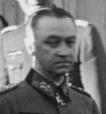Walter Weiß
Walter Weiß | |
|---|---|
 | |
| Born | 5 September 1890 Tilsit, Province of East Prussia, Kingdom of Prussia, German Empire |
| Died | 21 December 1967 (aged 77) Aschaffenburg, Bavaria, West Germany |
| Allegiance | |
| Service | |
| Years of service | 1908–45 |
| Rank | |
| Commands | 26 Infantry Division XXVII Army Corps 2nd Army Army Group North |
| Battles / wars | First World War World War II |
| Awards | Knight's Cross of the Iron Cross with Oak Leaves |
Walter-Otto Weiß, also spelt Weiss (5 September 1890 – 21 December 1967), was a German general during World War II. In 1945 he became commander in chief of Army Group North on the Eastern Front. He was a recipient of the Knight's Cross of the Iron Cross with Oak Leaves.
Career
[edit]Weiss was born in Tilsit, East Prussia[1] and joined the Army on 19 March 1908.[citation needed]
At the beginning of the Second World War, during the Polish Campaign, he was given command of I. Army Corps, holding the position chief of the general staff on 1 September.[citation needed]
On 15 December 1940 he took command of the 97th Jäger Division, leading the division with the rank of major-general until 15 January 1941.[2]
On 15 January 1941 command of the 26th Infantry Division. This Division was subordinated to Army Group Centre and participated in Operation Barbarossa.
Weiss took command of the XXVII Army Corps on 1 July 1942. Weiss led the 2nd Army on the Eastern Front from 3 February 1943 on. From 27 July to 5 August 1944, this involved leading the 2nd Army's defence and withdrawal battles during the Russian summer offensive Operation Bagration between the Pripyat and Bug River, including the evacuation of Brest-Litovsk on 28 July 1944.[3]
In January 1945, he asked Adolf Hitler for permission to withdrawal his forces further west as a result of attacking forces under the leadership of Konstantin Rokossovsky having reached the Vistula Lagoon. Hitler denied the request.[4] He also requested to withdrawal his forces from the town of Grudziądz but was denied permission by Reichsführer Heinrich Himmler, resulting in a significant battle that destroyed much of the town.[5]
He received command of Army Group North on 12 March 1945 and was tasked with the defence of Gdańsk Bay which his forces were unable to achieve.[6] He later surrendered the Army Group to the American forces.[citation needed]
He died 21 December 1967.[citation needed]
Awards
[edit]- Iron Cross (1914) 2nd Class (9 September 1914) & 1st Class (15 December 1915)[7]
- Clasp to the Iron Cross (1939) 2nd Class (19 September 1939) & 1st Class (2 October 1939)[7]
- German Cross in Gold on 19 February 1943 as General der Infanterie and commanding general of the XXVII. Armeekorps[8]
- Knight's Cross of the Iron Cross with Oak Leaves
- Knight's Cross on 12 September 1941 as Generalmajor and commander of the 26.Infanterie-Division[9]
- Oak Leaves on 5 November 1944 as Generaloberst and Commander-in-Chief of the 2. Armee[9]
References
[edit]Citations
[edit]- ^ "Walter Weiß - Munzinger Biographie".
- ^ Mitcham, Samuel W. (2007). German Order of Battle: 291st-999th Infantry divisions, named infantry divisions, and special divisions in World War II. Vol. 2. Mechanicsburg, PA: Stackpole Books. ISBN 978-0-8117-3437-0.
- ^ Nash, Douglas E. (2019-12-19). From the Realm of a Dying Sun. Casemate. p. 482. ISBN 978-1-61200-636-9.
- ^ Forty, Simon; Hook, Patrick; Cornish, Nik (2021-11-30). Red Army into the Reich. Casemate. p. 101. ISBN 978-1-63624-023-7.
- ^ Paterson, Lawrence (2021-12-22). Fallschirm-Panzer-Division 'Hermann Göring’. Greenhill Books. p. 252. ISBN 978-1-78438-613-9.
- ^ Thorwald, Jürgen (1980). Defeat in the East. ISBN 978-0-553-13469-8.
- ^ a b Thomas 1998, p. 429.
- ^ Patzwall & Scherzer 2001, p. 504.
- ^ a b Scherzer 2007, p. 776.
Bibliography
[edit]- Patzwall, Klaus D.; Scherzer, Veit (2001). Das Deutsche Kreuz 1941 – 1945 Geschichte und Inhaber Band II [The German Cross 1941 – 1945 History and Recipients Volume 2] (in German). Norderstedt, Germany: Verlag Klaus D. Patzwall. ISBN 978-3-931533-45-8.
- Scherzer, Veit (2007). Die Ritterkreuzträger 1939–1945 Die Inhaber des Ritterkreuzes des Eisernen Kreuzes 1939 von Heer, Luftwaffe, Kriegsmarine, Waffen-SS, Volkssturm sowie mit Deutschland verbündeter Streitkräfte nach den Unterlagen des Bundesarchives [The Knight's Cross Bearers 1939–1945 The Holders of the Knight's Cross of the Iron Cross 1939 by Army, Air Force, Navy, Waffen-SS, Volkssturm and Allied Forces with Germany According to the Documents of the Federal Archives] (in German). Jena, Germany: Scherzers Militaer-Verlag. ISBN 978-3-938845-17-2.
- Thomas, Franz (1998). Die Eichenlaubträger 1939–1945 Band 2: L–Z [The Oak Leaves Bearers 1939–1945 Volume 2: L–Z] (in German). Osnabrück, Germany: Biblio-Verlag. ISBN 978-3-7648-2300-9.
External links
[edit]![]() Media related to Walter Weiß at Wikimedia Commons
Media related to Walter Weiß at Wikimedia Commons
- 1890 births
- 1967 deaths
- People from Tilsit
- Military personnel from East Prussia
- Colonel generals of the German Army (Wehrmacht)
- German Army personnel of World War I
- Reichswehr personnel
- German Army generals of World War II
- Recipients of the Knight's Cross of the Iron Cross with Oak Leaves
- Recipients of the clasp to the Iron Cross, 1st class
- Officers of the Order of Military Merit (Bulgaria)
